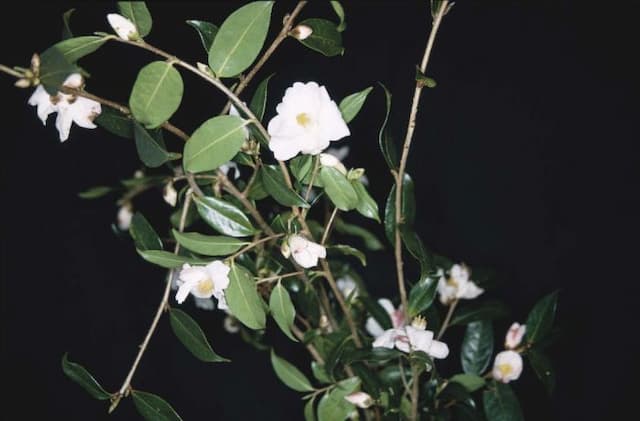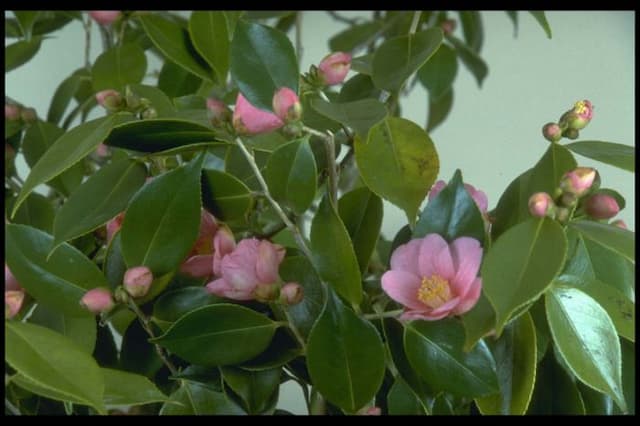Japanese Camellia Camellia japonica 'Elegans'

ABOUT
Camellia japonica 'Elegans', commonly known as the Japanese camellia, is a striking plant celebrated for its beautiful flowers. This variety boasts large, peony-like blossoms that can captivate any observer with their elegant charm. The flowers feature a rich and lustrous pink hue, with petals arranged in a loose, yet gracefully layered fashion. These petals sometimes display a unique marbling of white, giving each flower a distinctive appearance. The leaves of the Japanese camellia 'Elegans' are worth noting as well; they are glossy, dark green, and have a leathery texture, providing a lush backdrop for the showy blooms. The foliage remains evergreen, offering year-round visual interest, even when the plant is not in flower. The leaves are also finely toothed at the edges, adding a delicate detail to the robust plant. Overall, the Japanese camellia 'Elegans' is a plant of sophisticated beauty, with its stunning pink flowers and rich green foliage creating a captivating display that enhances any garden setting. Its appearance exudes a classic elegance that is often associated with traditional ornamental gardens.
About this plant
 Names
NamesFamily
Theaceae
Synonyms
Japanese Camellia, Common Camellia, Elegans Camellia
Common names
Camellia japonica 'Elegans'
 Toxicity
ToxicityTo humans
The Japanese Camellia is not considered toxic to humans. Therefore, ingesting parts of this plant typically does not result in poisoning or negative health consequences. It is always advisable to avoid eating ornamental plants as they are not intended for consumption and could cause gastrointestinal discomfort due to non-toxicity related issues.
To pets
The Japanese Camellia is also not considered toxic to pets. It is generally safe if pets come into contact with or ingest parts of this plant. However, as with humans, it is not advised for pets to consume ornamental plants because they might cause mild stomach upset due to reasons other than toxicity.
 Characteristics
CharacteristicsLife cycle
Perennials
Foliage type
Evergreen
Color of leaves
Green
Flower color
Pink
Height
6-10 feet (1.8-3 meters)
Spread
6-10 feet (1.8-3 meters)
Plant type
Shrub
Hardiness zones
7-9
Native area
Japan
Benefits
 General Benefits
General Benefits- Ornamental Beauty: Camellia japonica 'Elegans' adds aesthetic appeal to gardens with its large, showy flowers that come in an array of colors including pink, red, and white.
- Long Blooming Season: The blooming of this camellia typically extends from late winter through spring, providing color during a time when many plants are dormant.
- Shade Tolerance: This plant can thrive in partial shade, making it a versatile choice for gardens with varying light conditions.
- Drought Resistance: Once established, Camellia japonica 'Elegans' can tolerate periods of drought, making it suitable for drier climates or water-wise gardens.
- Evergreen Foliage: As an evergreen shrub, this plant provides year-round greenery and structure to a landscape.
- Privacy: Due to its dense growth habit, it can be used as a privacy hedge or screen.
- Habitat Support: The flowers provide nectar for pollinators, including bees and butterflies, supporting local ecosystems.
 Medical Properties
Medical Properties- Anti-inflammatory: Camellia japonica contains compounds that may help reduce inflammation in the body.
- Antioxidant: The plant has antioxidants which protect the body from oxidative stress and may improve overall health.
- Moisturizing: It is used in skincare for its hydrating properties, which can help maintain healthy skin barrier function.
- Wound healing: Some evidence suggests the plant may promote healing of minor wounds or skin abrasions.
 Air-purifying Qualities
Air-purifying QualitiesThis plant is not specifically known for air purifying qualities.
 Other Uses
Other Uses- As a fabric dye: The petals of Camellia japonica 'Elegans' can be used to create a range of pinkish dyes for fabrics, offering a natural coloring option for textiles.
- In floral crafts: The flowers can be pressed and used in scrapbooking, card making, or to embellish other decorative items due to their large size and vibrant color.
- As a natural ink: Juice from the petals can be used as a colored ink for artistic purposes or even as a natural food coloring.
- Leather conditioning: Oil extracted from seeds of the plant has been utilized in some cultures for conditioning leather goods, thanks to its moisturizing properties.
- As a carving material: The seed of the Camellia japonica 'Elegans' is hard and can be carved into beads or small trinkets, making use of the entire plant.
- In perfumery: The subtle fragrance of Camellia japonica 'Elegans' flowers can contribute to the formulation of perfumes, particularly in creating floral scent profiles.
- As a natural confetti: Dried petals of the plant can be thrown as eco-friendly confetti at celebrations such as weddings or parties.
- In potpourri: The petals, once dried, can retain some of their fragrance and color making them a visually appealing addition to potpourri mixes.
- For bonsai: Camellia japonica 'Elegans' can be cultivated as a bonsai specimen, showcasing the plant's natural beauty on a smaller scale.
- Photography projects: The vibrant blooms can be used in photography to create stunning images, or they can serve as the subject for botanical illustrations and paintings.
Interesting Facts
 Feng Shui
Feng ShuiThe Camellia is not used in Feng Shui practice.
 Zodiac Sign Compitability
Zodiac Sign CompitabilityThe Camellia is not used in astrology practice.
 Plant Symbolism
Plant Symbolism- Adoration: With its lush petals and rich color, Camellia japonica 'Elegans', commonly known as Camellia, often symbolizes deep adoration and affection.
- Love: Camellias are frequently associated with love, particularly red camellias, which can suggest a flame in the heart.
- Perfection: The Camellia's perfectly formed blossoms are symbols of perfection and excellence.
- Longevity: As an evergreen plant with a long blooming season, Camellias represent the idea of long life and endurance.
- Genuine: The simple yet elegant beauty of the Camellia stands for genuine, unreserved love.
- Pride: In certain cultures, giving a Camellia to someone is a way to express pride or admiration for their accomplishments.
 Water
WaterThe camellia, commonly known as Japanese camellia, should be watered deeply to ensure the roots get moisture, allowing the water to penetrate several inches into the soil. This plant prefers moist, well-drained soil, so water it with about 1 gallon once a week during the growing season. In hot, dry periods, you may need to water twice a week, but in the winter, reduce watering to half a gallon every two weeks. Ensure that the plant isn't left in standing water as this could lead to root rot.
 Light
LightJapanese camellias thrive in partial shade, preferably with morning sunlight and afternoon protection from the intense sun. They do well under the dappled light of a canopy or in an eastern-facing location that avoids the heat of late-day sun. Avoid placing them in full sun which can lead to scorching of the leaves.
 Temperature
TemperatureJapanese camellias flourish in a temperate climate and prefer temperatures between 68°F and 72°F. They can tolerate brief drops to around 10°F but freezing temperatures or drafts can damage the plant. Avoid exposure to temperatures over 85°F for prolonged periods as this may stress the plant.
 Pruning
PruningPrune the Japanese camellia to maintain its shape and remove any dead or diseased wood, preferably soon after the flowers have finished blooming. Lightly pruning throughout the growing season can encourage bushiness and control size. Major pruning should be avoided, as camellias are slow to recover from harsh cuts. The best time for pruning is in late winter or early spring.
 Cleaning
CleaningAs needed
 Soil
SoilThe Japanese Camellia 'Elegans' thrives best in acidic soil with a pH between 5.5 and 6.5. A well-draining soil mix composed of 2 parts peat moss, 1 part perlite, and 1 part organic compost provides the ideal conditions for the root system, ensuring proper moisture retention and nutrient availability. Regularly amending with organic matter will help maintain the soil structure and acidity levels optimal for camellia growth.
 Repotting
RepottingJapanese camellias like 'Elegans' generally require repotting every 2-3 years to ensure they have enough room to grow and that the soil remains fertile. It's best to repot in the late winter or early spring before the new growth starts, using an acidic soil mix that caters to their needs.
 Humidity & Misting
Humidity & MistingCamellia japonica 'Elegans' prefers a moderate to high humidity environment with levels ideally around 50-60%. Maintaining these humidity conditions will help ensure healthy growth and lush foliage for this ornamental shrub.
 Suitable locations
Suitable locationsIndoor
Place in bright, indirect light with some humidity, and monitor the soil moisture.
Outdoor
Provide partial shade, shelter from cold winds, and mulch to retain moisture.
Hardiness zone
7-9 USDA
 Life cycle
Life cycleCamellia japonica 'Elegans', commonly known as the "Elegans" camellia, begins its life as a seed that sprouts in moist, acidic soil in partial shade. The seedling stage involves the first emergence of delicate leaves as the root system establishes itself. As it enters the juvenile phase, the camellia plant gradually matures with a notable increase in leaf production and the development of a sturdy stem structure. The maturation process continues until the plant reaches its flowering stage, exhibiting large, ornate pink blooms typically during the fall to spring months. After pollination, the flowers develop into seed pods, completing the reproductive cycle. Finally, the camellia plant's lifecycle is perennial, allowing it to persist and flower for many years, even decades, with proper care and maintenance.
 Propogation
PropogationPropogation time
Spring-Early Summer
The most popular method for propagating Camellia japonica 'Elegans', commonly known as camellia, is through semi-hardwood cuttings. This technique typically takes place during the late summer or early autumn months. To begin, select a healthy branch that is not flowering and cut a segment approximately 4 to 6 inches (about 10 to 15 cm) long. The cutting should include several leaves, but the lower leaves are removed to expose a node. This node, once buried in a blend of moist peat and perlite, will encourage root development. The cut end of the branch may be dipped in a rooting hormone powder before planting to further increase the chances of successful rooting. The cutting should then be placed in a pot, covered with some form of plastic to retain humidity, and kept in a warm spot out of direct sunlight until roots have formed, which can take several months.









